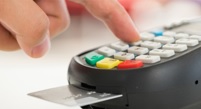 By National Retail Federation,
By National Retail Federation,
According to a new survey released today by the National Retail Federation, the majority of U.S. consumers — 62 percent — believe new credit cards being issued by banks don’t go far enough to protect card data or prevent fraud.
“Consumers are worried that chip-and-signature cards really amount to chip-and-chance,” NRF Senior Vice President for Government Relations Mallory Duncan said. “The chip cards are a step forward but shoppers are concerned that they don’t go nearly far enough. Unless the new cards require the use of a PIN, they will only provide half the safeguards needed to stop increasingly sophisticated criminals. The card industry’s refusal to give consumers the full protection they want continues to be a huge disappointment.”
Among those surveyed, 62 percent said they prefer chip-and-PIN cards over cards that just use chip and signature, and 63 percent said chip-and-PIN cards provide more data security than those that don’t. Among Millennials, the preference for PIN was even stronger, at 71 percent of those between the ages of 18 and 24 and 66 percent for those ages 25-34
Contrary to some banks’ claim that consumers don’t want to have to remember a PIN, the survey found 83 percent of consumers who say a PIN is more secure would consider it worthwhile even if they had to remember a different number for each card.
The survey also found 71 percent of consumers with a credit card have at least one chip card in their wallets, but that only 43 percent of credit cards are chip cards since most consumers have more than one card. Only 47 percent of consumers with a chip card have used it in a chip reader. The online survey of 2,035 U.S. adults ages 18 and older was conducted for NRF August 27 to September 2 by ORC International.
Starting October 1, there will be a major overhaul in how credit card transactions are processed and who is responsible for fraud costs. Under current credit card industry rules, banks are responsible for fraud losses when a counterfeit card is used and retailers are responsible when the person using the card is not the legitimate cardholder. Beginning October 1, banks will no longer honor their share of fraud costs if the card used is a chip card and the retailer does not have a chip card reader. Many retailers believe the liability shift is unfair because the chip reduces banks’ exposure to fraud while the lack of a PIN leaves retailers exposed to fraud.
The new cards, which banks have been rolling out over the past year, use EMV technology — short for Europay MasterCard Visa — to store data on an encrypted computer microchip. But unlike EMV cards used around the world for more than 20 years, which include a PIN, most cards being issued in the United States continue to use a signature to approve the transaction
Over the same period, retailers have had to pay for new card readers, which average about $2,000 each when related software, equipment, installation and other costs are included, or an estimated $35 billion nationwide. Most major retailers and many smaller merchants have installed the equipment, but many have reported that activation has been held up by bottlenecks such as delays in having the systems certified by card companies. That puts many retailers at risk for liabilities through no fault of their own.
“The chips partially address the issue of counterfeit cards, but do nothing about lost or stolen cards because thieves will still be able to sign any illegible scrawl to ‘prove’ that they are the cardholder,” Duncan said. “More importantly, sophisticated criminals can circumvent the chips, so a chip alone is not foolproof. A PIN is a secret password that makes the card useless to a criminal whether the card has a chip or not.”
– See more at: https://nrf.com/media/press-releases/consumers-say-new-credit-cards-not-safe-enough#sthash.qASycpjI.dpuf
Disclaimer: Articles featured on Oregon Report are the creation, responsibility and opinion of the authoring individual or organization which is featured at the top of every article.


